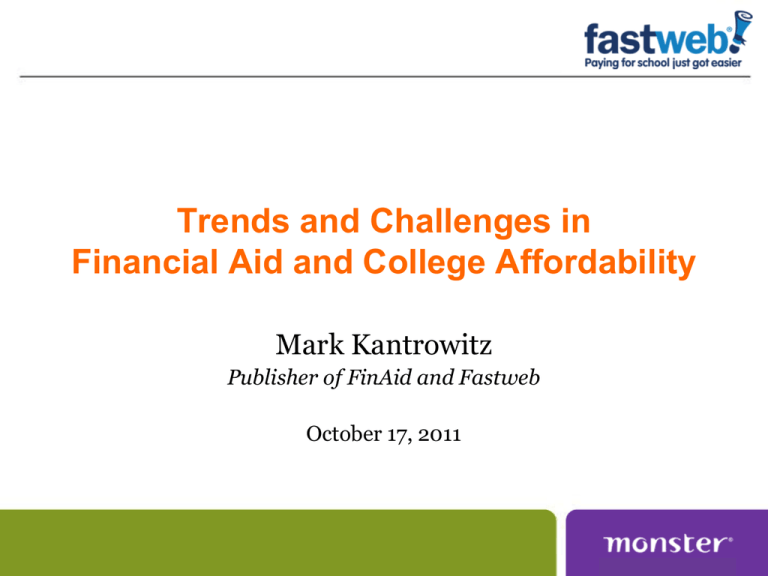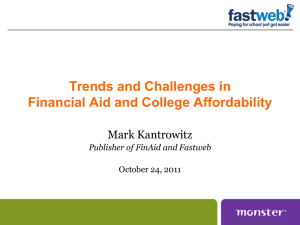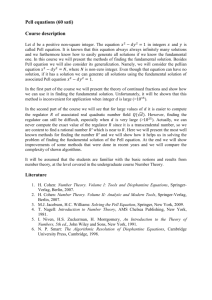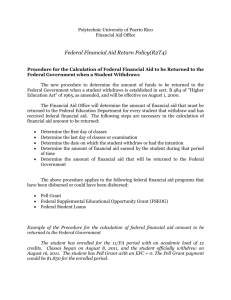Recent Cuts in Student Aid Funding
advertisement

Trends and Challenges in Financial Aid and College Affordability Mark Kantrowitz Publisher of FinAid and Fastweb October 17, 2011 Decrease in College Affordability Need-based grants are failing to keep pace with increases in college costs Federal and state governments are cutting student aid spending to reduce budget deficits College costs continue to rise • Public college tuition inflation is driven by cuts in state appropriations (effectively taxing students) • College discount rates are increasing, putting pressure on college student aid budgets Family income is stagnant due to the economy More families are demonstrating financial need Consequences of Drop in Affordability Families are more concerned about college costs and financial aid because of the increase in out-of-pocket costs Low and moderate income students shifting enrollments to lower-cost colleges, causing a decline in Bachelor’s degree attainment Average debt at graduation is increasing by thousands of dollars There is an increased focus on improving the efficiency and effectiveness of student aid funds Recent Cuts in Student Aid Funding Cuts to Pell Grant Program Funding Department of Defense and Full-Year Continuing Appropriations Act, 2011 (P.L. 11210) suspended the Year-Round Pell Grant program effective with the 2011-12 award year • The Year-Round Pell Grant program allowed students in accelerated degree programs to receive two Pell Grants in a single award year • This cuts $8 billion/year in Pell Grant program funding 2010-11 was also the last year of the Academic Competitiveness Grant (ACG) and National SMART Grant programs (SMART Grant) Increases in Funding are Inadequate Scheduled increases in maximum Pell Grant will fall short of inflation through 2020 • Health Care and Education Reconciliation Act of 2010 (P.L. 111-152) provided funding for anemic increases in the maximum Pell Grant through 2019-2020 • Five years of no increases, five years of CPI increases, the equivalent of CPI – 0.75% Budget Control Act of 2011 allocated $17 billion to the Pell Grant program for 2012-13 to address an existing funding shortfall, but left the program with a $1.3 billion funding shortfall Recent Growth in Pell Grant Program 2007-08 Recipients 2008-09 2009-10 2010-11 5.34 million 6.12 million 7.74 million 8.87 million Max Pell $4,310 $4,731 $5,350 $5,550 Average Pell $2,620 $2,970 $3,646 $4,115 $400 $890 $976 $555 $400 $400 plus $490 mandatory 10% of discretionary max plus $690 mandatory 10% of overall maximum $13.7 billion $16.26 billion $25.3 billion $32.9 billion Minimum Pell Minimum Pell Formula Appropriations Pell Grant appropriations doubled from 2008-09 to 2010-11 Number of recipients increased 45% from 2008-09 to 2010-11 Grew from a third of students in 2008-09 to almost half in 2010-11 Average Grant increased 39% from 2008-09 to 2010-11 Most Likely Changes to the Pell Grant Priority is on maintaining maximum Pell Grant of $5,550, but there will be no increases Cut subsidized interest on undergraduate subsidized Stafford loans to yield funding for Pell Grant program Reduce the number of semesters of eligibility from 18 to 12 for Bachelor’s degree programs, with lower limits for Certificate and Associate’s degree programs Require a minimum of half-time enrollment Eliminate eligibility for students who qualify for less than 10% of the maximum Pell Grant Changes to federal need analysis, such as changes to income protection allowance or auto-zero-EFC threshold Other Student Aid Cuts Are Likely Efficiency improvements from reallocating funds from one student aid program to another will be diverted toward deficit reduction • Budget Control Act of 2011 cut subsidized interest for graduate students and loan discounts, saving $21.6 billion, but redirected $4.6 billion to deficit reduction Budget Control Act of 2011 cut budget deficit, but did not specify what would be cut • Across-the-board budget cuts are likely • Extension of 3.4% subsidized Stafford loan interest rate for undergraduates is unlikely • Bush Administration tax cuts expire at end of 2012 Impact on College Affordability and Debt Growth in Student Loan Debt Student loan debt continues to grow faster than income, driven by the failure of grants to keep pace with increases in college costs Total student loan debt outstanding exceeded credit card debt outstanding in June 2010 Total student loan debt outstanding will reach the $1 trillion mark in late 2011 One-third of students are graduating with more than $20,000 in debt, eligible for 20-year or longer repayment terms Debt Catching Up with Income Income and Debt for Bachelor's Degree Recipients Average Debt at Graduation Average Income Age 25-34 $60,000 $48,445 $50,000 $43,302 $42,870 $40,000 $32,430 $30,906 $30,000 $23,118 $20,000 $17,299 $18,608 $12,759 $10,000 $9,320 $0 1992-1993 1995-1996 1999-2000 2003-2004 2007-2008 More Graduating with Excessive Debt Percent Bachelor's Degree Recipients with Debt-Service-to-Income Ratio ≥ 10% 14.0% 12.4% 12.0% 10.0% 9.2% 8.0% 6.0% 5.8% 5.6% 1995-1996 1999-2000 4.0% 2.3% 2.0% 0.0% 1992-1993 2003-2004 2007-2008 Higher-Cost Colleges Drive Excessive Debt Percentage of Bachelor's Degree Recipients Graduating with Excessive Debt by Cost of Attendance, 2007-08 50.0% 45.0% 40.0% 35.0% 30.0% 22.5% 25.0% 20.0% 15.2% 15.0% 10.0% 8.5% 9.7% 5.0% 0.0% Less than $10,000 $10,000 to $20,000 $20,000 to $30,000 $30,000 or More Cohort Default Rates Rising Again 2-Year Cohort Default Rates 25.0% 22.4% 20.0% 21.4% Cohort Default Rate 17.6%17.2% 15.0% 10.0% 17.8% 15.0% 11.6% 10.7% 9.6% 10.4% 8.8% 6.7% 7.1% 8.8% 6.9% 5.7% 5.9% 5.0% 5.5% 5.3% 4.5% 5.1% 4.6% 5.2% 0.0% 1986 1987 1988 1989 1990 1991 1992 1993 1994 1995 1996 1997 1998 1999 2000 2001 2002 2003 2004 2005 2006 2007 2008 2009 Cohort Year Debt Hurts Low-Income Enrollment The high cost/high aid model is pricing lowincome students out of a college education, especially when the aid includes loans and work Debt has a chilling effect on college enrollment by low-income students Low-income income students fear debt, causing them to enroll and graduate at 1/6 the rate of equally capable high-income students Imagine being asked to borrow more for your education than your parents earn in a year Pell Grant Recipients Graduate with More Debt Out-of-Pocket Costs vs. Total Income < $50,000 $50,000 to $100,000 > $100,000 Institution Type 2003-04 2007-08 2003-04 2007-08 2003-04 2007-08 Public 2-Year 35.4% 38.5% 8.4% 9.9% 4.3% 5.3% Public 4-Year 47.6% 53.8% 16.3% 19.0% 9.6% 11.6% Non-Profit 4-Year 58.8% 65.0% 24.2% 29.4% 17.0% 19.0% For-Profit 64.4% 76.3% 21.7% 33.0% 11.9% 21.3% Source: Analysis of data from the 2003-04 and 2007-08 National Postsecondary Student Aid Study (NPSAS) Out-of-Pocket = College Costs – Grants. Limited to families with positive out-of-pocket cost. Growth in Number of FAFSAs Number of Financial Aid Applications 25,000,000 21.1 million 19.5 million 20,000,000 16.4 million 14.0 million 14.6 million 15,000,000 11.4 million 10,000,000 5,000,000 - 2005-06 2006-07 2007-08 2008-09 2009-10 2010-11 Steady Increases in Discount Rate Average Discount Rate (NACUBO) Freshmen All Undergraduates Note: The range on the Y axis has been narrowed to show detail 44% 42.4% 42% 40% 38% 38.0% 37.3% 37.1% 34.3% 36% 34% 33.6% 32% 2000 2001 2002 2003 2004 2005 2006 2007 2008 2009 2010 2011 College Decision Impact Survey Greater emphasis on bottom line costs and ROI Three most important reasons chose college • • • • • • Quality of major (44.6%) Scholarship or financial assistance (43.2%) Total costs (40.8%) Academic reputation (38.4%) Campus setting/environment (35.6%) Close to home (34.5%) Students who are concerned about the economy are much more likely to enroll at public colleges “Switchers” Influenced by Money More likely to switch preference from non-profit to public (24%) than public to non-profit (9%) 37.3% of high school seniors did not enroll at their first-choice college. Main reasons: • A third (31.2%) said they could not afford 1st choice • A tenth (11.4%) got a better aid offer elsewhere • Among switchers from public to non-profit, a fifth (20.3%) said got a better aid offer • Among switches from public to non-profit, a third (33.0%) appealed for more aid and almost half (44.7%) got an increase in the financial aid offer More Emphasis on Improving Efficiency Potential for Greater Efficiency Given limited funding increases, there will be more emphasis on improving efficiency • Eliminate waste and abuse • Focus funding on the most effective programs • Target financial literacy training, debt counseling and job placement assistance at highest-risk borrowers Unfortunately, savings from efficiency improvements may be applied to deficit reduction instead of student aid Affordable debt restrictions (gainful employment rules) may be extended to all colleges Funding Constraints Infighting Funding for student aid will be flat or decrease, leading to a zero-sum game Improvements in the efficiency and effectiveness of student aid funding are not enough, and may be redirected at deficit reduction Public and non-profit colleges will attack the for-profit sector, which accounts for 1/4 to 1/3 of growth in federal grant and loan volume Politicians will blame the colleges for tuition inflation and declines in college affordability Colleges Need to Cut Costs Use technology such as online education to improve productivity and reduce costs Leverage economies of scale and centralization for greater efficiency Adopt a year-round class schedule for more efficient use of facilities 24/7/365 Increase student-faculty and student-staff ratios Eliminate underutilized and inessential services Improve retention and graduation rates Focus funding on the college’s core mission We Will Miss College Attainment Goal Growth in net price will hurt Bachelor’s degree attainment, making it more difficult to achieve President Obama’s 2020 goal to regain top slot in the OECD statistics Must have increases in student aid and improvements in student preparation Targeted counseling and services can help, but are not the complete solution Improvements in efficiency and effectiveness of existing student aid funding are not enough Thank You! Mark Kantrowitz’s student aid policy analysis papers may be found at www.finaid.org/studentaidpolicy








